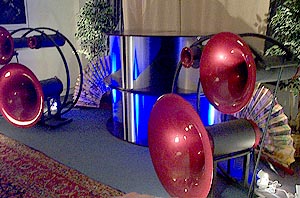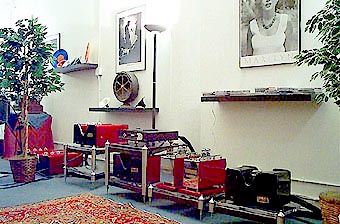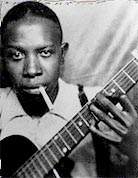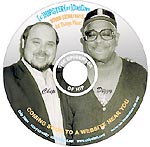 |
|||||||||||||||||||||||||||||||||
|
Mmmm, Mmmm, Goooood I mention all this in passing because again, I'm not normally drawn to larger-than-life depictions of recorded events. Nor am I accustomed to evaluating audio equipment outside the confines of my own listening room. But the size, layout, and clutter of my reference space mitigated against auditioning such a capacious system, particularly one so room-dependent, and --given the wide spread of the Trio's Classico configuration between drivers -- so reliant on the most meticulous of setups. |
|||||||||||||||||||||||||||||||||
 |
|||||||||||||||||||||||||||||||||
 |
|||||||||||||||||||||||||||||||||
From the word go, I found the sound and presentation of Visintainer's all-singing/all-dancing Trio-Basshorns reference system unique and utterly enthralling. Bob's implementation of this unique transducer technology is highly personal. It proceeds at the outset from the tried-and-true principles and style of system synergy, which Avantgarde distributor Jim Smith as the reigning US guru of horn loudspeakers himself has perfected over the years. However, where a visit to the Avantgarde Acoustic website finds the standard Trio model arranged in a more or less vertical configuration, augmented with a central array of six Basshorns, at Visintainer's Avantgarde Music & Cinema showroom, the trio of horns is deployed in the optional semi-circle Classico configuration. It gives a wider spread of drivers, which Visintainer feels makes for a wider, more open soundstage. And in a further break from standard Avantgarde setups, he positions his left-right array of Trio horns directly in from of their own discrete double-stack of Basshorns for a grand total of four, each containing a pair of 12" drivers with their own 200-watt amplifier to handle all frequencies below 100Hz. (The pictures with the blue-reflective central Basshorns above are from Srajan's visit during the store's November 2002 Grand Opening. Visintainer since moved the Basshorns behind the Trios as in the smaller image below.) |
|||||||||||||||||||||||||||||||||
 |
|||||||||||||||||||||||||||||||||
Given the wide spread of the horns in Visintainer's Trio array, the integration, center fill and coherence of the system was pretty remarkable. Straightaway, I was captivated by the speed and immensity of the sound: The Trio/Basshorn combo was blazingly fast, incredibly dynamic, frequency-extended, exceptionally detailed, lushly layered - and, curiously unrealistic, yet vividly lifelike. Do we detect a touch of irony here? Not really. Perhaps unrealistic isn't quite the word I'm looking for. Let's make that ... surrealistic as in beyond real. |
|||||||||||||||||||||||||||||||||
| That is to say, big, powerful, involving and in many ways larger than life, though not in the way I experienced the Martin-Logan reference system alluded to earlier in this article; not that individual instrumental images were so much larger than life (though they did seem appreciably bigger than what I'm accustomed to in dynamic loudspeakers). Rather, the gestalt of the musical experience was bigger and more dynamic; the aural canvas itself much larger, more vivid and encompassing, as the lateral breadth of the soundstage seemed to extend beyond the physical placement of the speakers. |
|||||||||||||||||||||||||||||||||
| In listening to one of my standard reference discs, the estimable Ralph Towner's A Closer View [ECM 1602], the literal presence of bassist Gary Peacock and guitarist Towner was quite vivid and palpable, yet on a certain level, I had to re-asses my accustomed experience of the music. Why? Well, the rise-time and dynamic headroom of each note was incredibly quick and expansive, while the lateral nature of the presentation was immense. Compared with the precision, transparency and depth of resolution I achieve with my own reference system, the Avantgarde/ Basshorn setup evinced a grander sense of - scale. |
|||||||||||||||||||||||||||||||||
 |
|||||||||||||||||||||||||||||||||
| This quality was driven home when I auditioned Pierre Boulez's 1971 Avery Fisher Hall recording of Stravinsky's Petrouchka [Sony Classical SMK 64 109]. The presentation was just more expansive on the Avantgarde's - they offered an utterly convincing sense of symphonic scale and complexity. Yet on a certain level, my system offered a more accurate presentation of the musical event (as well as the effect of gear up- and downstream), with greater holographic depth. By contrast, while the Avantgarde's all-encompassing lateral presentation seemed to lack something in the way of front-to-back depth, they nevertheless put me right on stage in the midst of the action. Was it the real thing? |
|||||||||||||||||||||||||||||||||
 |
|||||||||||||||||||||||||||||||||
| Hmmmmm - I don't know. But it was visceral enough that you could reach out and touch the performers. Was it just like live music? Wellllll, again, that's a reach, but it sure felt life-like, and what's more, it was just plain fun. Do I want to go out on a limb à la the Right Rabbi Michael Fremer and declare it to be Sisboombah, the greatest thing I've ever heard (at least until next month's gear comes in)? Not quite, and at this point I think it might be appropriate to air some of my caveats and misgivings. After several hours of rummaging through my fave reference discs, I went into anal audiophile mode and began nitpicking apart the sound (hey folks, that's why they pay us the insignificant bucks). While this $70,000 set of loudspeakers left little to be desired in the way of detail, dynamics or bass extension (and how), I became hyper-conscious of a certain softness to the presentation, a looseness to the overall focus. I began to long for tighter snap, a steelier, more forward presentation. Things were beginning to feel a tad too euphonic for my tastes. More significantly, as I analyzed different aspects of the system, it dawned on me that while some of that looseness was good -- as in the kind of richly layered midrange that is the province of high-quality single-ended tube amps -- I was also listening to a much greater proportion of noise artifacts than what I'd become accustomed to in my own system since I began using Equi=Tech Balanced Power Systems. I advised Bob that we could further enhance the dynamic range and transient snap of the system (especially of the Basshorns) by employing these devices. |
|||||||||||||||||||||||||||||||||
| Well, as it turns out, Jim Smith himself had been whispering the same message in Visintainer's ears. In fact, during our initial conversations, preparatory to me beginning these evaluations, Smith told me he'd been using some of the older Equi=Tech models for several years. He'd found them "... to be the only power line product I've ever used that sounds better than just plugging directly into the wall," and that he ran all of his front-end gear and power amps through them. So I guess that was all the push Visintainer needed, because when I returned to his showroom a month or so later, he'd purchased an Equi=Tech 2Q for his Basshorns and one 1.5Q for his own reference front end gear (and another for his secondary Avantgarde Uno system). | |||||||||||||||||||||||||||||||||
 |
|||||||||||||||||||||||||||||||||
Subsequently Bob experimented extensively with the Equi=Techs on front-end and power gear, and while his preferences wavered based on which amps he was using, he generally preferred using balanced power on his subs and front-end gear, while running the amps directly to the wall or through a passive line-conditioning device called the Velociter (wasn't that the machine the alien Dr. Exeter mailed to hunky scientist Dr. Cal Meacham in the sci-fi potboiler This Island Earth?). But that's another story, and one Bob should probably explain himself (he found the sound of amps straight into the wall "...more encompassing"). Me? I preferred the tighter, more centered, less congested sound of everything running through the Equi=Techs (as I was used to in my home system), and for much of my remaining listening, while we went back and forth, Bob by and large indulged my preferences. To further up the ante, I brought along a set of JPS Labs Aluminata AC Cords, which to these ears really double-clutched the dynamic impact of the Equi=Techs and made the entire system sound bigger, faster and more focused (the trade-off being reduced euphony). |
|||||||||||||||||||||||||||||||||
 |
|||||||||||||||||||||||||||||||||
I also brought along some Acoustic Zen Gargantua II AC Cords for the liquidity and musicality they confer on front-end gear, while the superb Cardas Golden Reference Interconnects and Speaker Cables completed our neurological interface. Rounding out the system were a pair of 30-watt Audiopax Mono 88 (with cryogenically treated KT-88 output tubes), a Viva Linear 45 Pre-Amp and an Audio Aero Capitol 24/192 tubed CD player, all resting upon Valid Points while sitting atop Grand Prix Audio equipment stands with carbon fiber shelves. |
|||||||||||||||||||||||||||||||||
 |
The system I'd initially experienced was exceptionally musical, with captivating levels of midrange creaminess and liquidity, but the tweaks I introduced made it sound bigger and more focused to me on the predominantly acoustic mix of music I was auditioning. Now that I was able to discount the influence of noise artifacts, I was simply floored by the enormity of the sound and the incredible sensitivity, dynamic headroom and lack of audible distortions that distinguished the Trio/Basshorn system. |
||||||||||||||||||||||||||||||||
When I put on violinist Regina Carter's "Alexandra" from her most recent release, Paganini: After A Dream [Verve 440 065 554-2], I was seduced by the enormity of her tone and instrumental presence on the unaccompanied intro, and the manner in which notes seemed imbued by a halo of inky silence as the overtones decayed into an immense ambient canvas. |
|||||||||||||||||||||||||||||||||
 |
|||||||||||||||||||||||||||||||||
Again, there was a slightly surreal quality to the music, but I was impressed by the enormous foundation of well-damped low frequencies the Basshorns conferred on the musical experience, and the manner in which these seemingly bottomless behemoths geometrically enhanced low-level details and acoustic room cues. |
|||||||||||||||||||||||||||||||||
There was something alive about the presentation, not as in an approximation of life, neither as something inherently larger than life - but as the real thing. I experienced the music almost exactly as I had some months before when I heard Regina and this same band perform this tune from a ringside seat at Birdland in New York (for more details on this gig and Regina's music, see my Spring Dog Yummies column at Positive Feedback On-line). Regina was right there in the room with me. Vis-à-vis my other gut reactions, in wrapping up I found something quite curious that I'd jotted down in my notes which seems worth mentioning here, to wit: "...with music that has an unrealistic, processed studio sound, the Trio/Basshorn combo makes the experience seem more real and involving. With music that is more rigorously recorded as to portray the most realistic possible acoustic, the experience is slightly surreal." While I attribute some of this to the fundamental nature of the Avantgarde Trio's three-horn driver architecture (with its extraordinary 110dB sensitivity)... this purely conjecture, but such is how I experienced the sound, so indulge me for a second: |
|||||||||||||||||||||||||||||||||
It occurred to me as I listened to film composer John Barry's larger-than-life portrayal of brass, electric guitars, mallet instruments, harpsichord and drum kit on his expansive arrangement of the main theme to "On Her Majesty's Secret Service" from The Best of Bond: James Bond Collection [Capitol 72435-40554-2-3], that when creating music like this in the studios, producers often rely on enormous, elephant-ear in-wall loudspeakers (routinely with high-frequency horn drivers) to mix the music, thus naturally gravitating towards a larger-than-life presentation, which hence was perfectly suited to the Trio/Basshorn combo. |
|||||||||||||||||||||||||||||||||
 |
|||||||||||||||||||||||||||||||||
 |
|||||||||||||||||||||||||||||||||
On the other hand, while experiencing the deep, spatial acoustic of Arcadi Volodos' Schubert: Solo Piano Works [Sony Classical SK 89647], I wondered if the people recording this music had indeed referenced it on much smaller near-field monitors. While the experience was richly detailed, fulsomely detailed and profoundly involving, I found the scale of the piano to be out of proportion with my experience of listening to piano recordings on high-end systems. |
|||||||||||||||||||||||||||||||||
| In the end, it all comes down to personal tastes. In other words, as a reviewer, I certainly found my own home system to be more realistic -- if also more limited in scale and impact -- and more conducive for adjudging the sonic signatures and individual merit of all the gear that crosses my path. But for sheer pleasure, left to my own devices, if I had the money and my big dream house out in the Adirondacks on Lake No-Compromise? I would probably opt to have two systems -- one for work and one for fun. Not that my current reference system doesn't deliver a big, transparent, holographic soundstage, wonderful dynamics, a very believable top-to-bottom frequency response, wonderful midrange layering and a deeply involving sense of detail and dimensionality. | |||||||||||||||||||||||||||||||||
 |
|||||||||||||||||||||||||||||||||
But the pricey, no-compromise Avantgarde Trio/Basshorns system is most enticing, and delivers an unmistakably visceral adrenaline charge that is positively Wagnerian, and which could prove most addictive to well-heeled rock and rollers who don't know from HighEnd audio, but know that they've never heard anything like this in their life - and that they have to have it. Because these speakers are so bloody efficient and so low in audible distortions, they give you a lot of ambient information. By the same token, the temptation to crank them up beyond the regular pale is almost irresistible - and I must say (with great affection) that Bob Visintainer is the only motherfucker I've ever met who drives his system harder and louder than I do. [Not for nuttin' is Chip's underground nome-de-guerre "Clip Stern aka Count Vlad the Impaler" - Ed.] There certainly came a point beyond which I found it all a bit too loud. If it doesn't exactly lose coherence, it certainly becomes way too in-yer-face. |
|||||||||||||||||||||||||||||||||
Which is easy enough to understand. If you have a high-performance car, it's only natural to want to open her up and see what she can do in overdrive. That's because the sound of the Avantgarde Trio/Basshorn system as I experienced it isn't simply involving - it's enveloping. And when I concluded my evaluations, nothing drove home this point quite like contrasting the experience of listening to an ancient mono recording of my beloved Robert Johnson singing "Me And the Devil Blues" on my six-cylinder compact home rig and on Bob Visintainer's nitro-methane, balloon-tire hot rod. On both, Johnson's voice and guitar were beautifully centered, with goose-bump inducing details galore; both systems delivered a deep spiritual connection and a sense of genuine physical proximity to the artist. While listening on my system, the speakers disappeared. However, in listening to the Avantgarde Trio/Basshorn system, the room itself seemed to disappear. |
|||||||||||||||||||||||||||||||||
 |
|||||||||||||||||||||||||||||||||
| Nuff' said? |
 |
||||||||||||||||||||||||||||||||
 |
|||||||||||||||||||||||||||||||||
|
To e-mail reviewer, click name;
for his bio, click next. |
|||||||||||||||||||||||||||||||||
Bob Visintainer replies: Srajan: Reading Chip Stern's review of my Trio/Basshorn system was definitely interesting. I must admit the time that Chip spent at the store, with the system, was a bit - surreal. As you read through Chip's assertions, you realize that his proficiency with the English language allows him to describe nuances that may not be normally contemplated with a less efficient mechanism for description. Comments and thoughts.....
Others like a much more focused, very precise sound, with a visceral display of macrodynamics and, more importantly, microdynamics. Again, with a few subtle adjustments -- including Audiopax Timbre-Lock controls, Basshorn crossover frequency controls, and bass-level controls -- along with switching a few cables here and there, the Trios can deliver this combination. Dear Srajan, Listen, I went even further than Chip. After 24 years, I left the industry, never intending to return. That is - until I heard/felt music from a pair of Avantgardes, an event that forever changed my perception of the power of music in the home! |
|||||||||||||||||||||||||||||||||
 |
|||||||||||||||||||||||||||||||||
 |
|||||||||||||||||||||||||||||||||
| Manufacturer's website US distributor's website |
|||||||||||||||||||||||||||||||||
|
NYC showroom website
|
|||||||||||||||||||||||||||||||||
 |
|||||||||||||||||||||||||||||||||